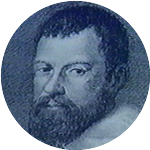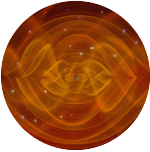Newsletter for April, 2021
Welcome to the fourth of our monthly newsletters. We will be bringing this to your mailbox around the middle of each month, to keep you informed about Planetarium and Friends news, as well as happenings in the world of astronomy and events in our area related to science education. Visit the website for more news updates and a list of our articles.
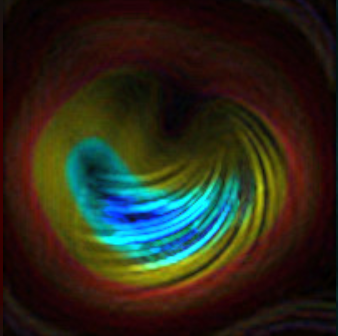 Magnetic Fields Around a Black Hole
Magnetic Fields Around a Black Hole
By imaging the polarization of the light emitted
by the plasma surrounding the supermassive black hole at the center of the M87 galaxy, scientists have been able to map the magnetic field in its vicinity, and its evolution over a week of observations.

Psyche Made of Iron
The picture shows the asteroid Psyche imaged by the Very Large Telescope's adaptive optics SPHERE imager. Psyche was first discovered in 1853 by Annibale de Gasparis and was named after the Greek goddess of the soul. Now Tracy M. Becker and collaborators have make observations of UV light reflected from the asteroid which indicate an iron composition. However, they point out that the observations are also consistent with just a 10% surface iron composition, as the spectrum may be dominated by reflections from small iron grains. Psyche may be the exposed core of an early planet. NASA plans a mission to Psyche to begin its journey next year and reach the asteroid in 2026.
The picture shows the asteroid Psyche imaged by the Very Large Telescope's adaptive optics SPHERE imager. Psyche was first discovered in 1853 by Annibale de Gasparis and was named after the Greek goddess of the soul. Now Tracy M. Becker and collaborators have make observations of UV light reflected from the asteroid which indicate an iron composition. However, they point out that the observations are also consistent with just a 10% surface iron composition, as the spectrum may be dominated by reflections from small iron grains. Psyche may be the exposed core of an early planet. NASA plans a mission to Psyche to begin its journey next year and reach the asteroid in 2026.

The
Moon is Getting Rusty
Rust (iron oxide) has been detected on the Moon. But how could that have happened, when the Moon has no atmosphere, and therefore no oxygen? The theory is that a small amount of oxygen from the Earth was captured by the Moon, perhaps a billion years ago, when the two were closer together. The oxygen molecules could have travelled along the Earth’s magnetotail, the part of its magnetic field that is stretched out by the solar wind.
Rust (iron oxide) has been detected on the Moon. But how could that have happened, when the Moon has no atmosphere, and therefore no oxygen? The theory is that a small amount of oxygen from the Earth was captured by the Moon, perhaps a billion years ago, when the two were closer together. The oxygen molecules could have travelled along the Earth’s magnetotail, the part of its magnetic field that is stretched out by the solar wind.
Mars Helicopter Ingenuity Touches Down
NASA's Mars helicopter landed on the surface of Mars after being dropped by the Perseverance rover, according to an announcement on April 3. Since then a software problem has delayed its first
flight, but a fix has been deployed, and the craft is expected to lift off shortly.
Clouds on Mars
The Right Navigation Camera on NASA's Mars rover Curiosity captured a lovely image of Twilight clouds over “Mont Mercou” on Sol 3072.
Armand Spitz – Champion of Planetariums
Though he started out as a journalist, Armand Spitz (1904-1971) was enamored with astronomy. He wrote a basic astronomy textbook, participated in early radio and television broadcasts about astronomy, and lectured at Philadelphia’s Fels planetarium for many years. In the 1940s, planetariums were extremely expensive to build, so Spitz spent years developing a lower cost projector to make dome theaters more affordable. 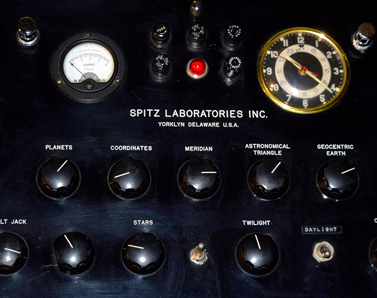
Contributed by Kathi Overton
Interstellar Comet 2I/Borisov
Until recently, there had been exactly one interstellar object detected within our Solar System, the mysterious 1I/‘Oumuamua. Now there are two: polarimetric observations of comet 2I/Borisov using the European Southern Observatory Very Large Telescope strongly indicate that it comes from beyond our system. In addition, the shape of its orbit shows that it is not gravitationally bound to the Sun.
Until recently, there had been exactly one interstellar object detected within our Solar System, the mysterious 1I/‘Oumuamua. Now there are two: polarimetric observations of comet 2I/Borisov using the European Southern Observatory Very Large Telescope strongly indicate that it comes from beyond our system. In addition, the shape of its orbit shows that it is not gravitationally bound to the Sun.
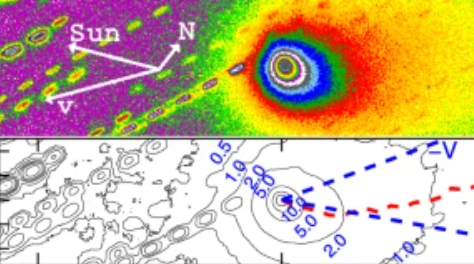
Satellite Pollution
As communities on Earth attempt to mitigate light pollution, the increasing population of artificial satellites, put in orbit chiefly to provide internet service, has become a major contributor to this threat to astronomy. Estimates now put their projected contribution to light pollution at 10% in the near future. This form of light pollution is particularly insidious, because it is nearly impossible to evade by seeking a dark observing location.
As communities on Earth attempt to mitigate light pollution, the increasing population of artificial satellites, put in orbit chiefly to provide internet service, has become a major contributor to this threat to astronomy. Estimates now put their projected contribution to light pollution at 10% in the near future. This form of light pollution is particularly insidious, because it is nearly impossible to evade by seeking a dark observing location.
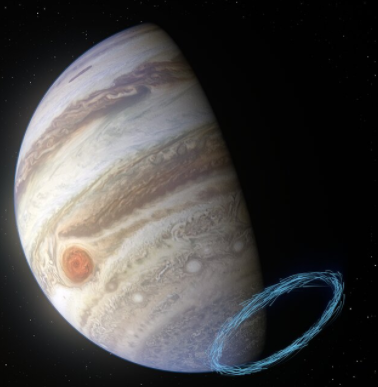
Fierce Winds on Jupiter
When the comet Shoemaker–Levy 9 smashed in to Jupiter in 1994, it left behind a dusting of hydrogen cyanide molecules in the atmosphere. Scientists have used these molecules as tracers to measure the winds on Jupiter in parts of its atmosphere that, until now, have been invisible, as they do not contain clouds. The surprising result is a region with extemely fast winds of 400 m/s near the poles. The measurements were made using the Atacama Large Millimeter/submillimeter Array in the Atacama Desert in northern Chile.
When the comet Shoemaker–Levy 9 smashed in to Jupiter in 1994, it left behind a dusting of hydrogen cyanide molecules in the atmosphere. Scientists have used these molecules as tracers to measure the winds on Jupiter in parts of its atmosphere that, until now, have been invisible, as they do not contain clouds. The surprising result is a region with extemely fast winds of 400 m/s near the poles. The measurements were made using the Atacama Large Millimeter/submillimeter Array in the Atacama Desert in northern Chile.


 witter
witter Instagram
Instagram
